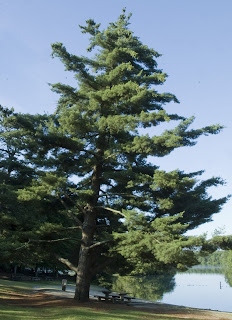Common Name: White pine
Family: Pinaceae

Penwood State Park, Bloomfield, CT
Plant is Native to: North America: throughout all of New England; from Newfoundland to Georgia and west to Iowa. Hardy to zone 3
Plant Height at maturity: 50 to 80 feet tall, by 30-50 feet wide, can reach over 100 feet tall. Plant Habit and Form: Tall, straight coniferous tree. Conical when young, has wispy, upturned, horizontal branches in maturity. Many lateral branches creates a moderately dense canopy. Fine texture and fast growing.

Voluntown, CT

Foliage: Thin, flexible evergreen needles, 3 to 5 inches long, with 5 soft, blue-green needles in each fascicle. Leaf sheath is deciduous. Serrated margins and two stomatal lines on underside.

 Voluntown, CT
Voluntown, CT
Bark: When young, bark is smooth, gray-green, with some splotches. When mature, becomes reddish-brown to gray-brown, with scaly, rounded ridges and long furrows. New stems are somewhat silvery-gray.

 Voluntown, CT
Voluntown, CT
Flower: Monoecious. Male flowers are yellow, cylindrical in clusters near branch tip. Females are light green, red-tinged, at ends of branches.

Fruit/Seed: Cones are 6 to 8" long, cylindrical, thick rounded scales. Light brown color, often numerous. Typically clustered in the upper third of the tree. Take two years for cones to reach maturity, mature in late summer.
 Evergreen Way, Manchester, CT
Evergreen Way, Manchester, CT Growing Requirements: Easily transplanted, easily gown. Prefers moist, well-drained, slightly acidic soil. Prefers sun, although young trees tolerate light shade. Cold tolerant.
Problems and Drawbacks: White pine weevil is common, causing leader death, but plants recover with an altered form. Wood is weak and cannot tolerate strong winds. Susceptible to salt, air pollution and white pine blister rust. Often suffers significant damage from ice and heavy snows.
Special Uses: Good specimen for parks or other large spaces; Dwarf cultivars make nice borders and mass plantings. Can be sheared, but if shearing is stopped will send our vigorous top growth which overgrows bottom branches. Used as Christmas tree.
ID Tips/Remarks: 5 needles per fascicle; serrated leaf margins; thin drooping needles. Smooth gray or silvery bark often with a green tint on younger branches. Cones are long, pendant and slightly curved. Most widely used pine in the Northeast.
Bibliography:
http://www.cnr.vt.edu/dendro/dendrology/syllabus/factsheet.cfm?ID=111
Dirr, Michael A. Manual of Woody Landscape Plants, 1998 Stipes Publishing, Champaigne, IL
No comments:
Post a Comment